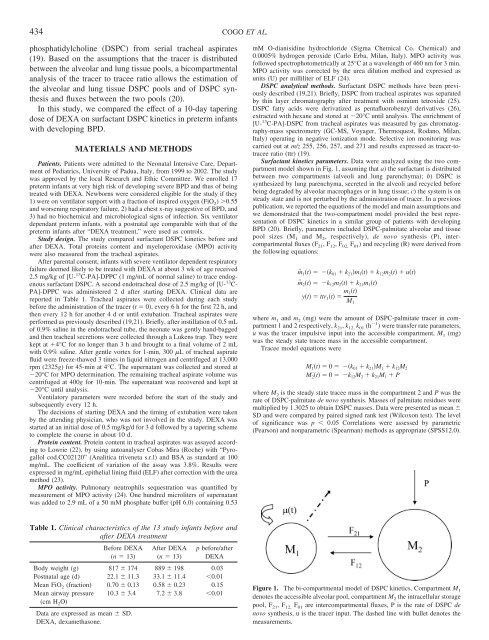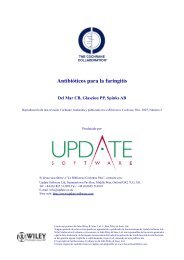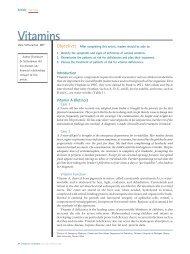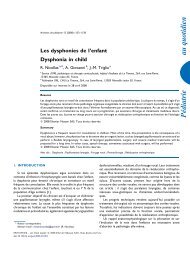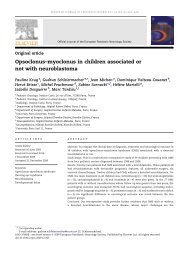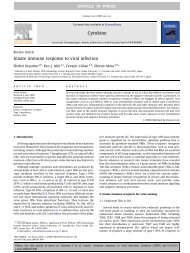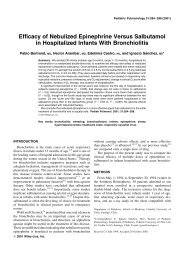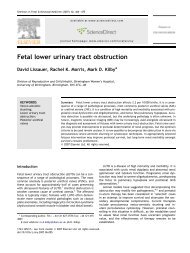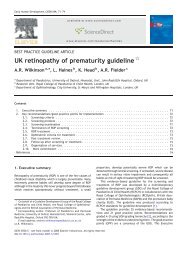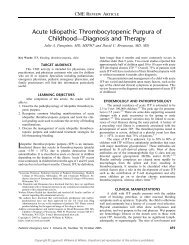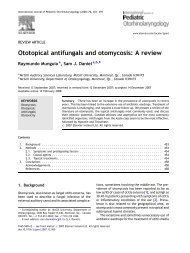Dexamethasone Therapy in Preterm Infants Developing ... - sepeap
Dexamethasone Therapy in Preterm Infants Developing ... - sepeap
Dexamethasone Therapy in Preterm Infants Developing ... - sepeap
Create successful ePaper yourself
Turn your PDF publications into a flip-book with our unique Google optimized e-Paper software.
434 COGO ET AL.<br />
phosphatidylchol<strong>in</strong>e (DSPC) from serial tracheal aspirates<br />
(19). Based on the assumptions that the tracer is distributed<br />
between the alveolar and lung tissue pools, a bicompartmental<br />
analysis of the tracer to tracee ratio allows the estimation of<br />
the alveolar and lung tissue DSPC pools and of DSPC synthesis<br />
and fluxes between the two pools (20).<br />
In this study, we compared the effect of a 10-day taper<strong>in</strong>g<br />
dose of DEXA on surfactant DSPC k<strong>in</strong>etics <strong>in</strong> preterm <strong>in</strong>fants<br />
with develop<strong>in</strong>g BPD.<br />
MATERIALS AND METHODS<br />
Patients. Patients were admitted to the Neonatal Intensive Care, Department<br />
of Pediatrics, University of Padua, Italy, from 1999 to 2002. The study<br />
was approved by the local Research and Ethic Committee. We enrolled 17<br />
preterm <strong>in</strong>fants at very high risk of develop<strong>in</strong>g severe BPD and thus of be<strong>in</strong>g<br />
treated with DEXA. Newborns were considered eligible for the study if they<br />
1) were on ventilator support with a fraction of <strong>in</strong>spired oxygen (FiO 2 ) 0.55<br />
and worsen<strong>in</strong>g respiratory failure, 2) had a chest x-ray suggestive of BPD, and<br />
3) had no biochemical and microbiological signs of <strong>in</strong>fection. Six ventilator<br />
dependant preterm <strong>in</strong>fants, with a postnatal age comparable with that of the<br />
preterm <strong>in</strong>fants after “DEXA treatment,” were used as controls.<br />
Study design. The study compared surfactant DSPC k<strong>in</strong>etics before and<br />
after DEXA. Total prote<strong>in</strong>s content and myeloperoxidase (MPO) activity<br />
were also measured from the tracheal aspirates.<br />
After parental consent, <strong>in</strong>fants with severe ventilator dependent respiratory<br />
failure deemed likely to be treated with DEXA at about 3 wk of age received<br />
2.5 mg/kg of [U- 13 C-PA]-DPPC (1 mg/mL of normal sal<strong>in</strong>e) to trace endogenous<br />
surfactant DSPC. A second endotracheal dose of 2.5 mg/kg of [U- 13 C-<br />
PA]-DPPC was adm<strong>in</strong>istered 2 d after start<strong>in</strong>g DEXA. Cl<strong>in</strong>ical data are<br />
reported <strong>in</strong> Table 1. Tracheal aspirates were collected dur<strong>in</strong>g each study<br />
before the adm<strong>in</strong>istration of the tracer (t 0), every 6 h for the first 72 h, and<br />
then every 12 h for another 4doruntil extubation. Tracheal aspirates were<br />
performed as previously described (19,21). Briefly, after <strong>in</strong>stillation of 0.5 mL<br />
of 0.9% sal<strong>in</strong>e <strong>in</strong> the endotracheal tube, the neonate was gently hand-bagged<br />
and then tracheal secretions were collected through a Lukens trap. They were<br />
kept at 4°C for no longer than 3 h and brought to a f<strong>in</strong>al volume of 2 mL<br />
with 0.9% sal<strong>in</strong>e. After gentle vortex for 1-m<strong>in</strong>, 300 L of tracheal aspirate<br />
fluid were freeze-thawed 3 times <strong>in</strong> liquid nitrogen and centrifuged at 13,000<br />
rpm (2325g) for 45-m<strong>in</strong> at 4°C. The supernatant was collected and stored at<br />
20°C for MPO determ<strong>in</strong>ation. The rema<strong>in</strong><strong>in</strong>g tracheal aspirate volume was<br />
centrifuged at 400g for 10-m<strong>in</strong>. The supernatant was recovered and kept at<br />
20°C until analysis.<br />
Ventilatory parameters were recorded before the start of the study and<br />
subsequently every 12 h.<br />
The decisions of start<strong>in</strong>g DEXA and the tim<strong>in</strong>g of extubation were taken<br />
by the attend<strong>in</strong>g physician, who was not <strong>in</strong>volved <strong>in</strong> the study. DEXA was<br />
started at an <strong>in</strong>itial dose of 0.5 mg/kg/d for 3 d followed by a taper<strong>in</strong>g scheme<br />
to complete the course <strong>in</strong> about 10 d.<br />
Prote<strong>in</strong> content. Prote<strong>in</strong> content <strong>in</strong> tracheal aspirates was assayed accord<strong>in</strong>g<br />
to Lowrie (22), by us<strong>in</strong>g autoanalyser Cobas Mira (Roche) with “Pyrogallol<br />
cod.CC02120” (Analitica triveneta s.r.l) and BSA as standard at 100<br />
mg/mL. The coefficient of variation of the assay was 3.8%. Results were<br />
expressed <strong>in</strong> mg/mL epithelial l<strong>in</strong><strong>in</strong>g fluid (ELF) after correction with the urea<br />
method (23).<br />
MPO activity. Pulmonary neutrophils sequestration was quantified by<br />
measurement of MPO activity (24). One hundred microliters of supernatant<br />
was added to 2.9 mL of a 50 mM phosphate buffer (pH 6.0) conta<strong>in</strong><strong>in</strong>g 0.53<br />
mM O-dianisid<strong>in</strong>e hydrochloride (Sigma Chemical Co. Chemical) and<br />
0.0005% hydrogen peroxide (Carlo Erba, Milan, Italy). MPO activity was<br />
followed spectrophotometrically at 25°C at a wavelength of 460 nm for 3 m<strong>in</strong>.<br />
MPO activity was corrected by the urea dilution method and expressed as<br />
units (U) per milliliter of ELF (24).<br />
DSPC analytical methods. Surfactant DSPC methods have been previously<br />
described (19,21). Briefly, DSPC from tracheal aspirates was separated<br />
by th<strong>in</strong> layer chromatography after treatment with osmium tetroxide (25).<br />
DSPC fatty acids were derivatized as pentafluorobenzyl derivatives (26),<br />
extracted with hexane and stored at 20°C until analysis. The enrichment of<br />
[U- 13 C-PA]-DSPC from tracheal aspirates was measured by gas chromatography-mass<br />
spectrometry (GC-MS, Voyager, Thermoquest, Rodano, Milan,<br />
Italy) operat<strong>in</strong>g <strong>in</strong> negative ionization mode. Selective ion monitor<strong>in</strong>g was<br />
carried out at m/z 255, 256, 257, and 271 and results expressed as tracer-totracee<br />
ratio (ttr) (19).<br />
Surfactant k<strong>in</strong>etics parameters. Data were analyzed us<strong>in</strong>g the two compartment<br />
model shown <strong>in</strong> Fig. 1, assum<strong>in</strong>g that a) the surfactant is distributed<br />
between two compartments (alveoli and lung parenchyma); b) DSPC is<br />
synthesized by lung parenchyma, secreted <strong>in</strong> the alveoli and recycled before<br />
be<strong>in</strong>g degraded by alveolar macrophages or <strong>in</strong> lung tissue; c) the system is on<br />
steady state and is not perturbed by the adm<strong>in</strong>istration of tracer. In a previous<br />
publication, we reported the equations of the model and ma<strong>in</strong> assumptions and<br />
we demonstrated that the two-compartment model provided the best representation<br />
of DSPC k<strong>in</strong>etics <strong>in</strong> a similar group of patients with develop<strong>in</strong>g<br />
BPD (20). Briefly, parameters <strong>in</strong>cluded DSPC-palmitate alveolar and tissue<br />
pool sizes (M 1 and M 2 , respectively), de novo synthesis (P), <strong>in</strong>tercompartmental<br />
fluxes (F 21 ,F 12 ,F 02, F 01 ) and recycl<strong>in</strong>g (R) were derived from<br />
the follow<strong>in</strong>g equations:<br />
m 1t k 01 k 21 m 1 t k 12 m 2 t ut<br />
m 2t k 12 m 2 t k 21 m 1 t<br />
yt ttr 1 t m 1t<br />
M 1<br />
where m 1 and m 2 (mg) were the amount of DSPC-palmitate tracer <strong>in</strong> compartment<br />
1 and 2 respectively, k 21 , k 12, k 01 (h 1 ) were transfer rate parameters,<br />
u was the tracer impulsive <strong>in</strong>put <strong>in</strong>to the accessible compartment, M 1 (mg)<br />
was the steady state tracee mass <strong>in</strong> the accessible compartment.<br />
Tracee model equations were<br />
M 1 t 0 k 01 k 21 M 1 k 12 M 2<br />
M 2 t 0 k 12 M 2 k 21 M 1 P<br />
where M 2 is the steady state tracee mass <strong>in</strong> the compartment 2 and P was the<br />
rate of DSPC-palmitate de novo synthesis. Masses of palmitate residues were<br />
multiplied by 1.3025 to obta<strong>in</strong> DSPC masses. Data were presented as mean <br />
SD and were compared by paired signed rank test (Wilcoxon test). The level<br />
of significance was p 0.05 Correlations were assessed by parametric<br />
(Pearson) and nonparametric (Spearman) methods as appropriate (SPSS12.0).<br />
Table 1. Cl<strong>in</strong>ical characteristics of the 13 study <strong>in</strong>fants before and<br />
after DEXA treatment<br />
Before DEXA<br />
(n 13)<br />
After DEXA<br />
(n 13)<br />
p before/after<br />
DEXA<br />
Body weight (g) 817 174 889 198 0.03<br />
Postnatal age (d) 22.1 11.3 33.1 11.4 0.01<br />
Mean FiO 2 (fraction) 0.70 0.13 0.58 0.23 0.15<br />
Mean airway pressure 10.3 3.4 7.2 3.8 0.01<br />
(cm H 2 O)<br />
Data are expressed as mean SD.<br />
DEXA, dexamethasone.<br />
Figure 1. The bi-compartmental model of DSPC k<strong>in</strong>etics. Compartment M 1<br />
denotes the accessible alveolar pool, compartment M 2 the <strong>in</strong>tracellular storage<br />
pool, F 21 ,F 12, F 01 are <strong>in</strong>tercompartmental fluxes, P is the rate of DSPC de<br />
novo synthesis, u is the tracer <strong>in</strong>put. The dashed l<strong>in</strong>e with bullet denotes the<br />
measurements.


